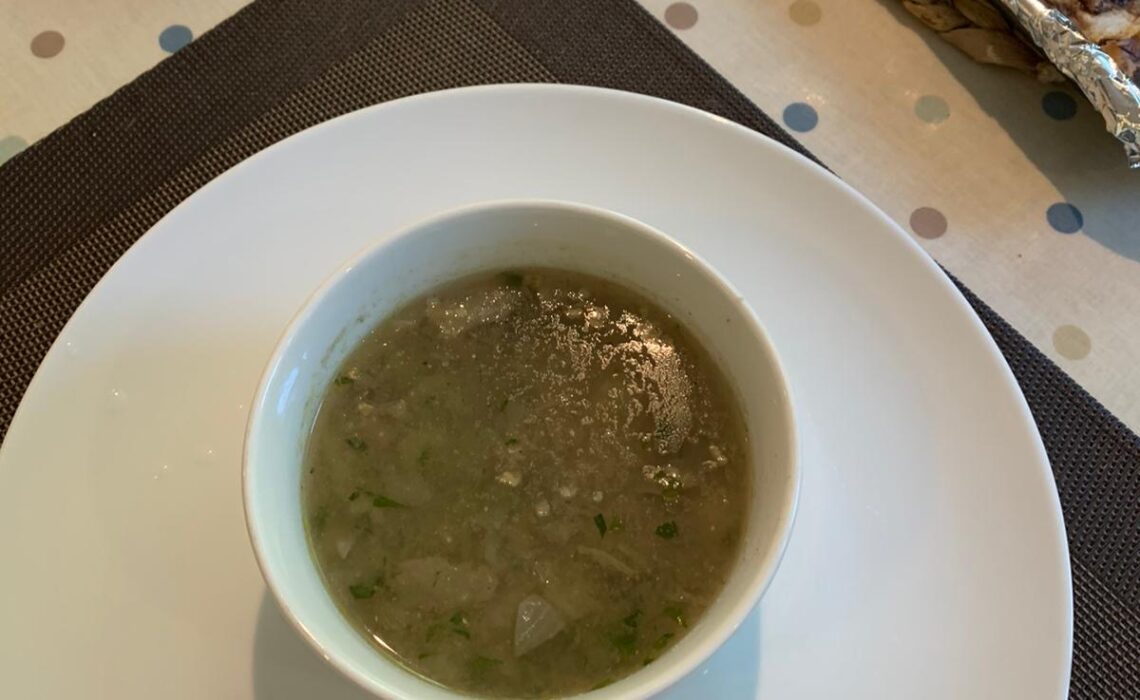
There must be thousands of different types of soup worldwide, as they exist in every cuisine from East to West and from North to South, with all the cultures in between. Although I like many types of soups, I am no authority on the subject. However, I am going to relate to you four very popular soups from the Levant Cuisine.
You may ask, why four? Because they are different in terms of one primary ingredient but have the same preparation approach and almost identical ingredients. So, you are getting good value for money from this blog but, let’s keep it as our little secret!
The other ‘simple’ feature of these soups is that they are generally named after the one ingredient that is different for each of them. The four soups are called:
- Rice Soup – best if you use short-grain or risotto rice
- Sh’eereyeh (Vermicelli) Soup – this is very thin pasta strands, sometimes known as angel hair pasta
- Freekeh (Green wheat) Soup – Wheat is harvested early when the grains are still soft and chewy. Before threshing the wheat, it is roasted on low heat open fire to give a smoky taste to the grain. The grains are allowed to dry and then stored for use in various Middle Eastern dishes. Whole freekeh grain is used as an alternative, and often tastier than rice. In fact, freekeh has twice the amount of fibers and three time the protein found in rice. For soup, the freekeh grains are roughly ground before use. Freekeh is enjoying growing popularity these days and can be found in many supermarkets and if all fails, try Middle Eastern stores.
- Vegetable Soup – this is an all-year type of soup, using whatever vegetables are in season at the time. So, this is your opportunity to create your own version of this soup with a hint of Middle Eastern taste.
So, here are the main tips I know to make four delicious soups, which my wife Claire calls ‘penicillin for the soul’, and my daughter Leila calls ‘a hug in a mug’:
- Always use best quality ingredients, they really make a difference.Use fresh in-season vegetables in preference to frozen ones but avoid canned vegetable at all costs. Also, use good quality spices, herbs and olive oil.
- You can create totally vegetarian soup or, in my view, the better and richer flavoured soup is when you use free-range chicken.Use any part of the chicken but the parts that give out the best flavour are the boney ones like legs, wings, etc. The idea is not to have the chicken meat overwhelm the soup but mostly to give it body and flavour. In fact, I often serve myself a bowl or mug of soup and leave out any chicken pieces altogether. For a vegetarian version, use vegetable stock cubes to enhance the flavour.
- Start by creating the base stock, which is almost identical for all four soups.The variation is in the amounts of spices you use. Personally, I tend to add more cardamom to the Freekeh soup than the other three.
- The base stock is to sauté chopped onions and add the chicken pieces to lightly brown them.You then cover in boiling water and add the three main spices of: a few whole bay leaves, a cinnamon stick, and a few pods of roasted cardamoms (roasting the cardamoms releases a very pleasant pungent aroma). In addition, add salt and ground black pepper to taste. Allow to cook on low/ medium heat for 30 minutes or so, or until the chicken is almost cooked. Fish out the bay leaves, cinnamon stick and cardamom pods; they have served their purpose by now.
- As a general rule, you need to cook the base stock until the chicken is almost ready to eat.The word ‘almost’ varies between the four soups. More on this further down.
- If and when you decide to garnish with fresh chopped parsley, add just before serving and avoid adding while the soup is still cooking; it looks and tastes better with the parsley floating on the surface of the soup.
- Rice Soup: remember that rice is starchy, and it increases in size so, be sparing with the amount you use. Also, rice doesn’t need a great deal of cooking time, especially if you like your rice ‘al dente’ so, the base stock needs to be almost ready when you add the rice. Another tip, you may wish to add chopped mushrooms with the rice. In that case, use light-coloured mushrooms such as Button, Oyster or Enoki to avoid darkening the look of the soup.
- Sh’eereyeh Soup: break the vermicelli strands to be roughly 3 to 4 cm in length. In a separate skillet or open pan, roast the pasta until it starts to turn golden. Drop immediately into the base stock no more than 5 minutes before the stock is fully cooked.
- Freekeh Soup: dried freekeh grain is tough and requires more time to cook with the base stock. As mentioned earlier, you may wish to add ground roasted cardamoms with the freekeh; I personally would. The freekeh will need some 30 minutes or so to cook and will release its own type of starch, which adds to the overall texture and flavour, especially the smoky aroma. One point to bear in mind is that the freekeh may have remnants of husk amongst the grain, which I suggest you pick off before cooking the freekeh as they don’t cook well and take away from the enjoyment of the soup.
- Vegetable Soup: I am an advocate of using in-season vegetables so, it is almost impossible to be precise to suggest specific vegetables to include in this soup. There are however ‘always available’ vegetables you can add such as carrots, potatoes and cauliflower. As for the in-season vegetables, the sky is the limit as to what you may want to add according to your personal taste. Dice the vegetables to the size of a sweetcorn kernel. Don’t worry about the fact that some vegetables cook more quickly than others however, I would cook them for long enough for the softest to cook, leaving the rest in a firmer state, which I believe gives a better taste than having your vegetables mashed up and almost puréed.
Sprinkle each serving with some freshly chopped parsley and eat on its own, with croutons or fresh bread such as ciabatta.
A final tip. If you try any or all of these soups, why don’t you do what we do. We make a big batch of the base stock and freeze in Tupperware containers to bring out, defrost and prepare one of the four soups fairly quickly.
If you would like my detailed 4-soup recipes, please let me know and I will send you a copy.
Go on, disinfect your soul and have a hug in a mug!
Mufid Sukkar – May 2020



All sound delicious – may I have the detailed recipies please?
Delicious soups 😋
What about the queen of soups ‘Lentil soup’
Coming very soon. Lentil soup deserves its own blog